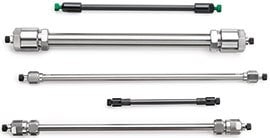How to Extend Liquid Chromatography Column Life: Regenerate or Use Guard Columns
Egidijus Machtejevas
Any HPLC or UHPLC column can typically be used for only a limited number of injections. Correct usage and maintenance of the column extends its lifetime and benefits the economy of the method. It is important to follow generally accepted chromatography practices, like adequate sample preparation (sample should be filtered through 0.45 µm membrane filter for HPLC and 0.22 µm filter for UHPLC); suitable quality/purity of the mobile phase (for example, isocratic grade solvents for isocratic mode, gradient grade solvents for gradient elution); filtered mobile phase, well developed method with sufficiently strong elution to minimize unspecific sorption; temperature, pH, and maximum backpressure ranges compatible with selected column. Also important to mention is that the total number of injections is inversely proportional to the volume of the sample injected, e.g., if 10 µL sample is applied per injection and this results in a column lifetime of 5000 injections, then an increased sample load of 100 µL per injection would typically shorten column lifetime to approximately 500 injections. Even if all the above listed points are carefully followed, users sometimes feel that column lifetime should be longer. In order to find out how to extend the lifetime of the column, it is first necessary to understand what causes the aging of the column.

Figure 1.HPLC or UHPLC column
- Column contamination/clogging by particles. Keep in mind that your column is a very efficient filter. Any particulate material coming from the mobile phase or sample will contaminate frits, and some particles might also migrate into the column packing. This will result in an increase in column backpressure. This creates more stress for the pump and can cause a column to settle, creating a void which result in peak splitting.
- Unspecific sorption. An HPLC column can encounter many different substances during its use, such as salts from buffers or impurities from the mobile phase and sample. These materials can have lesser or greater retention than the analytes separated. These undesired interferences, if observed by the detector, appear as ghost peaks, blobs, baseline upsets or even negative peaks. Absorbed impurities might negatively contribute to retention mechanism (shorten retention) or begin to act as a new stationary phase (increased retention).
- Column repacking. Every particle packed column contains a range of particle sizes. Particle size distribution might be wider or narrower. During chromatographic analysis, columns will experience pressure stresses when a non-pressurized injection loop is connected to a pressurized column. During these pressure stresses, the column packing is getting shocked, then particles might swap positions, causing the generally bigger particle to go up (towards column inlet), and the smaller down (towards column outlet). After a number of injections, smaller particles will accumulate at the bottom, and bigger at the top. The smaller particle zone then has a higher packing density backpressure, which users will observe due to the steady increase in backpressure. This again creates more pressure for the instrument and can cause a column to settle, creating a void and consequently peak splitting.
Many customers are asking for procedures which could regenerate a column to the initial performance level in order to extend column lifetime. Therefore, the importance of very carefully reading the instruction sheet which comes with every column cannot be overstressed. The sheet also contains information about suggested column care and regeneration procedures. This advice must be followed and can be different from column/phase type to column/ phase type. However, we can theoretically analyze how efficient column regeneration might be. Column contamination at the inlet by particles should generally be easily removed by washing the column for about 5 to 20 column volumes in a backflush mode, but only if the column manufacturer allows it. It is important to make sure that both column frits (inlet and outlet) have the same porosity. Please keep in mind that small impurity particles trapped deeper in the column packing are very unlikely to be removed. As a result of this washing, the column backpressure should be somewhat decreased. To remove unspecifically bound material from the column is often more difficult and the outcome is usually unpredictable, because typically we do not know what compounds these contaminants contain. The success ratio might be from 0 to 100%. To fully restore column packing uniformity for columns packed with smaller than 5 µm particles is very unlikely. Normally column backflush only helps for a short time.
So, what is the most reliable and certain solution offered for this topic? The use of guard columns! Guard columns will filter all particles, accumulate unspecific adsorbed materials, and will also extend the lifetime of the analytical main columns used at marginally alkaline pH. Typically, when the guard column is replaced, a majority of the problems will be eliminated, and even more importantly, it will occur without any lengthy time and solvent consuming washing procedure with questionable outcome. Important note: the Guard column must be the same particle size as the analytical column, the same modification and the same material type.
But how will you know when to replace the guard column? General advice: Replace the guard column when the nature of the sample is changing, when backpressure is increased about 10-15%, or by schedule/time basis (for example, every 200 to 500 injections – depending on the injection volume and sample purity).
If you routinely have any problems with the lifetime of your main column, think early enough about guard columns to save yourself analytical headaches.
To continue reading please sign in or create an account.
Don't Have An Account?